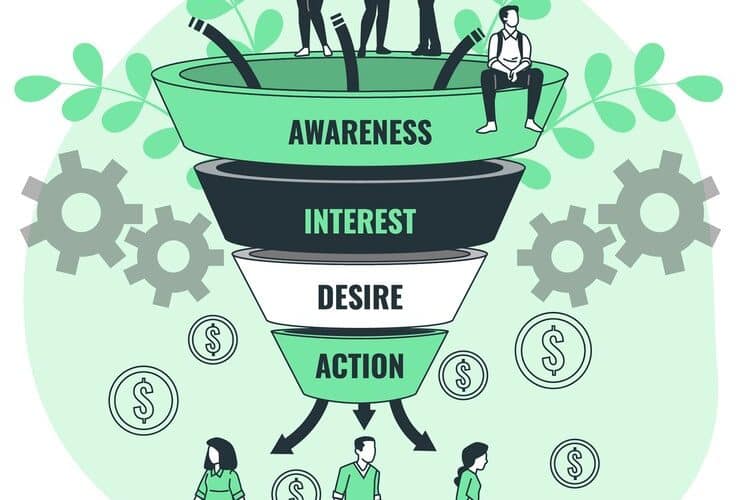If you’ve ever worked in marketing, you know that the ultimate goal is to convert potential consumers into repeat customers. So, how do you get there? The solution is to fully understand and create a lead funnel. Whether you are an experienced marketer or a small business owner looking to expand your online presence, creating a successful lead funnel is an essential strategy for streamlining the process of acquiring leads and converting them into paying customers. In this article, I’ll explain what a lead funnel is, why it’s important, the various stages involved, and how to build one for your business.
Key Takeaways
- A lead funnel guides potential customers from awareness to purchase. It ensures marketing efforts are streamlined and effective, preventing disjointed approaches that fail to convert leads into paying customers.
- Lead funnels can take many forms, such as content, social media, email marketing, PPC, and event funnels, each with tailored strategies to guide prospects through the buying process and build trust.
- Both marketing and sales teams play crucial roles at different funnel stages. While marketing focuses on generating awareness and interest, sales step in during the desire and action stages to close deals.
- While lead funnels standardize the customer journey, personalization in marketing and sales remains critical. Customizing content and communication based on customer needs at various stages increases the likelihood of conversions.
- Successful lead funnels require tools to track customer interactions from the first contact to the final sale. Monitoring the journey allows businesses to adjust strategies, optimize conversion rates, and improve the customer experience.
What is a Lead Funnel?
A lead funnel is a step-by-step process used by businesses to acquire, nurture, and convert prospective customers (leads) into paying customers. Consider it a journey—your objective is to guide your prospects from the minute they learn about you until they make their first purchase.
Simply put, it’s a customer acquisition path, with each stage of the funnel bringing customers closer to a choice. But why is it called a funnel? The reason is simple: as you move through the stages, the number of persons tends to decrease, resulting in a funnel-shaped diagram.
Without a lead funnel, your marketing efforts can feel disjointed. Have you ever spent hours promoting your product only to wonder why the conversions aren’t coming? That’s most likely because you didn’t have a framework in place to help potential leads make decisions.
Before we get into how lead funnels work, let’s define the distinctions between lead generation funnels, sales funnels, and sales pipelines.
Lead Generation Funnel
In general, all sales funnels aim to move a customer closer to making a purchase. However, not every customer is created equal, and not all customers are at the same stage in the funnel. That is the primary distinction between lead and sales funnels. Lead generation funnels are primarily concerned with potential customers who have never purchased from your organization and who you hope will progress to the sales lead funnel.
Sales Lead Funnel
While it shares some similarities with the lead generation funnel, your sales lead funnel is a repeatable process that can be used with both new and repeat clients, from product awareness to product purchase. Ideally, all prospects in the sales lead funnel are existing customers or qualified leads from the lead generation funnel. Separating the two funnels entails using the proper approaches to the right prospects at the right point of their purchasing journey.
Sales Pipeline
While they share similarities with lead and sales funnels, sales pipelines are more concerned with the sales representative rather than the customer. For example, if a prospect is in the awareness stage of the sales funnel, the sales rep is the relevant contact stage in the sales pipeline.
Now that you have a better understanding of what lead funnels are, let us look at how they work.
How Does a Lead Funnel Work?
Lead funnels operate by streamlining your whole lead process (from marketing to sales) to make lead conversion easier and more efficient. That is not to say that every prospect receives the same treatment—personalization in marketing and active listening in sales are still critical to customer conversion—but it does imply that all prospects will go through similar processes during their buyer journey.
Not all prospects will make it through the full funnel on their first attempt; some may never make it. That is okay. The most significant component of the funnel is that it aligns everyone’s efforts on the sales and marketing teams so that every customer is presented with a unified vision of a brand and sales style.
Why Is a Lead Funnel Important?
Without a lead funnel, your marketing efforts can feel disjointed. Have you ever spent hours promoting your product only to wonder why the conversions aren’t coming? That’s most likely because you didn’t have a framework in place to help potential leads make decisions. A lead funnel is crucial for several reasons.
- It allows you to see the customer journey. Understanding the various stages of the funnel allows you to discover where potential consumers are dropping off and take steps to increase your conversion rate.
- It helps you focus your marketing efforts. A lead funnel can assist you in prioritizing your marketing operations and allocating your resources efficiently.
- It helps you build relationships. By nurturing leads throughout the funnel, you may develop relationships with potential consumers and boost their likelihood of making a purchase.
Lead Funnel Stages
Let’s look at each stage of the lead funnel and talk about certain strategies for attracting and converting leads.
- Awareness: Awareness is the initial stage of the lead generation funnel where a potential customer becomes aware of a product or service. This is typically accomplished through advertising, content marketing, referral marketing, and so forth.
- Interest: At this stage, a prospective customer shows interest in the product or service and requests additional information. They may undertake research, compare products, and seek feedback from friends and family.
- Desire: The third stage occurs when the potential buyer develops a strong desire for the goods or services. They may grasp the benefits and be inspired to take action.
- Action: At the end of the marketing funnel, the customer makes a purchase. This is where the company’s sales and marketing strategies are put to the test.
- Loyalty (optional): Some models incorporate a loyalty stage in which clients become repeat customers and refer others to the company.
A well-designed funnel can help organizations increase conversions and revenue by directing prospects through the purchasing process and developing relationships with potential clients. The lead funnel must include both marketing and sales efforts, as both play a significant role at different phases of the purchasing process.
Types of Lead Funnels
Let’s break into a couple of unique lead funnel types that you might come across:
- Content Funnels: These funnels are all about engaging your audience with intriguing content. Whether it’s blog articles, videos, infographics, or podcasts, the idea is to deliver value to your audience by educating, entertaining, or informing them, moving them closer to a choice. Content funnels are effective at building trust and authority in your sector, making them an essential component of a long-term lead-generating strategy.
- Social Media Funnels: Using the power of social platforms, these funnels focus on capturing leads via social media posts, interactions, and adverts tailored to networks such as Facebook, Instagram, Twitter, and LinkedIn.
- Email Marketing Funnels: These funnels use targeted email marketing to guide prospects through the purchasing process. Email funnels can be quite efficient in nurturing leads, providing tailored value, and ultimately converting them into loyal customers if you segment your audience and tailor messages to meet them at different phases of their journey.
- PPC (Pay-Per-Click) Funnels: PPC funnels are designed to drive traffic and conversions through sponsored advertisements. These could be search ads, display ads, or social media ads. The funnel method entails establishing landing pages that are optimized to capture leads from advertisements, followed by a sequence of processes aimed at converting these leads into customers.
- Event Funnels: These funnels are designed for virtual or real events like webinars, workshops, conferences, or product launches. The goal is to attract participants’ interest and contact information by providing valuable content or experiences and then following up to convert them into clients.
Sales vs. Marketing Qualified Lead
Qualified leads are important for sales and marketing because they represent potential clients interested in your products or services. In essence, a qualified lead is an individual or organization who has expressed interest in your product or service and possesses the ability and authority to make a purchase.
There are two types of leads: marketing qualified leads (MQLs) and sales qualified leads (SQLs), which reflect distinct stages of the purchasing process.
- MQLs have expressed interest by signing up for newsletters or engaging with social media content, but they are not yet ready to make a purchase. They require more information and nurturing.
- SQLs have expressed a definite desire to purchase, for example, by requesting a demo or asking about items. They’re regarded as ready for direct sales efforts.
Understanding the difference between MQLs and SQLs allows you to customize your strategy, nurturing MQLs with relevant content while focusing sales efforts on SQLs for improved conversion and customer acquisition.
The Role of Marketing and Sales in a Lead Funnel
Lead funnels can be further segmented into two stages: marketing and sales. Let us look at these presently.
#1. Marketing stages
In today’s increasingly digital environment, creating an effective marketing strategy entails considerably more than just advertising. A marketing funnel creates distinct paths for customers to interact with your brand; while they enter the funnel at the top via marketing campaigns or email marketing, further down the funnel, you can use tools like lead scoring and feedback forms to tailor marketing messages to each customer’s specific needs.
Marketing channels typically include features such as content marketing and advertising (for example, Facebook Ads) to drive traffic to a company’s website or blog posts. When a potential consumer visits the website, a lead magnet entices him to provide his contact information. This is all part of the lead generation process.
After potential consumers provide their information (becoming a lead), they can be nurtured using strategies such as remarketing advertisements or email marketing to become qualified prospects and advance through the sales funnel. The marketing team is often responsible for the first two stages of the marketing funnel: awareness and interest.
#2. Sales stages
When a lead reaches the interest stage of the funnel, it is often routed to the sales department. At this stage, potential clients frequently contact the organization to learn more about its offers.
However, it should be emphasized that more and more clients choose to remain anonymous at this step of the sales funnel. Such customers browse the company’s pages, look for case studies, and visit websites such as g2.com to read reviews about the company or its products. This is why sales and marketing teams must collaborate on strategies.
When clients get to the next step, desire, they are already sales-qualified prospects and may be passed on to sales representatives. Depending on the prospective customer’s needs, the time between desire and action might be brief or lengthy. The more intricate and costly the product or service, the more complex and time-consuming the sales negotiations.
Lead Funnel Example
Allow me to guide you through a real-world lead funnel example from one of my previous projects.
I worked with a SaaS startup that sought to increase its customer base. We began by building a blog that addressed common industry pain points and targeted terms that potential clients were searching for. Once we had visitors, we used pop-ups to give them a free eBook in exchange for their email addresses.
Next, we sent a series of automated emails over two weeks. These emails included success stories, links to free webinars, and offers of a free trial of the software. At the end of the sequence, our leads were well-informed and eager to try the product, resulting in a 25% conversion rate from lead to paying customer.
How to Create a Lead Funnel Step-by-Step
The correct sales funnel will be determined by a variety of aspects, including products, market details, the number of personnel in marketing and sales teams, the marketing budget, and existing technological resources. Here’s a step-by-step guide to creating a sales funnel.
#1. Identify your target market and buyer personas.
Defining your target market is essential for making your sales funnel as effective as possible. To begin, analyze who your current customers are and target comparable purchasers or people who meet their demographics.
#2. Research your competitors to understand their strategies.
To design an effective sales funnel, it’s vital to research your competitors and understand their strategies. Take the time to evaluate their sales strategies so that you can implement market-tested principles.
#3. Develop a common plan amongst the sales and marketing teams.
The customer path (from prospect to customer) crosses two teams, both of which play critical roles in the entire process. In a normal journey, the marketing team is responsible for reaching out to potential customers and generating interest, while the sales team is in charge of sealing the purchase.
#4. Create a system to track leads from first contact until sale.
As businesses strive for greater efficiency and productivity, tracking leads from first contact to sale is critical. To create a seamless sales funnel, sales reps must have the necessary tools to effectively track prospects from start to finish.
#5. Choose the best ways to communicate for each funnel stage.
Companies should consider developing a precise sales funnel to efficiently steer prospects from interest to purchase. It is critical to understand what potential customers require and want at each level, as well as to determine the appropriate communication strategies for each stage of the funnel.
#6. Provide your sales team with tools and knowledge.
Your sales team cannot function without enough preparation. Make sure they have all they need to successfully work with prospects. This comprises, among other things:
- Knowledge
- Tools
- Materials and Templates
Lead Funnel Template
Creating a lead funnel template can help you manage your marketing efforts, ensuring that no stages are overlooked. Here’s a simple template to follow:
- Top of the Funnel (TOFU): Use blog articles, infographics, and social media to increase awareness.
- Send out case studies, whitepapers, and email newsletters to generate interest.
- Bottom of the Funnel (BOFU): Use free trials, demos, and limited-time offers to close the purchase.
When I created my own lead funnel template, I noticed how much more effective my marketing got. I wasn’t wasting time trying to “wing it” anymore; instead, I had a well-defined strategy for approaching each lead at every level.
“Our lead funnel template will help you identify bottlenecks in your sales process and improve your conversion rate. Download it now and take your business to the next level.”
What are the benefits of lead generation funnel?
Benefits of lead generation that drive success:
- Expand your market.
- Grow your following.
- Gather more customer reviews.
- Boost your revenue.
- Generate business opportunities.
- Improve lead quality.
- Build visibility and awareness
What are top-of-the-funnel leads?
Top-of-funnel: Refers to the early stages of a sales funnel, such as attracting new clients and leads. TOF content is often broader and seeks to educate or inform the audience about a general topic relevant to their interests, rather than directly marketing a specific product or service.
What is an example of a lead generation funnel?
An example of a lead generation funnel could include a blog article that answers key questions about your niche and exposes your audience to your business.
Conclusion
Building an effective lead funnel does not happen quickly, but with the correct methods, it can be a game changer for your organization. By nurturing your leads through each stage of the funnel, you can convert more visitors into repeat customers. So, are you ready to create your own lead funnel? Have you used a lead funnel before, or are you just getting started?
Related Articles
- LEADING CHINESE BRANDS MAKING A GLOBAL IMPACT IN 2024
- Utilizing Marketing Automation for Effective Lead Generation
- How I Maximize Lead Generation Using Automation: Best Tools in 2024
- What Is Lead Generation Data: Purpose, Analysis, Tools and Best Strategy
- 7 Proven Ways to Develop Thought Leadership Strategy for Your Company






